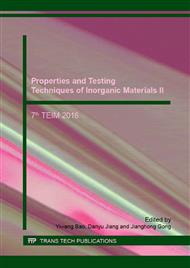p.43
p.50
p.55
p.60
p.65
p.70
p.75
p.80
p.85
Determination of ZrO2 and TiO2 in Alkali-Resistant Fiberglass Mesh by ICP OES
Abstract:
The content of ZrO2 and TiO2 in alkali-resistant fiberglass mesh was determined by ICP OES. The sample was pretreated by acid-soluble and alkali-fusion methods. Compared with the results of standard method, the results showed that the method can be used for the determination of ZrO2 and TiO2 in alkali-resistant fiberglass mesh. Standard solutions were prepared based on the content of elements. The best analysis of spectral lines was determined for each element. Blank solution was prepared and injected ten times continuously. The corresponding concentration of three times of standard deviation (3S) was used to calculate the detection limit of the method, and the detection limit was from 0.0018% to 0.0047%. The corresponding concentration of ten times of standard deviation (10S) was used to calculate the quantitation limit of the method, and the limit of quantitation was from 0.0060% to 0.016%. Six repeated tests were performed on two samples, and the relative standard deviations (RSDs (n=6)) of the test were from 0.60% to 0.78%. Compared to standard method, absolute error was less than 0.2% and the relative error was less than 2.0%. The results showed that the method can be used for simultaneous determination of ZrO2 and TiO2 in alkali-resistant fiberglass mesh., with fast analysis and reliable results.
Info:
Periodical:
Pages:
65-69
Citation:
Online since:
January 2017
Authors:
Keywords:
Price:
Сopyright:
© 2017 Trans Tech Publications Ltd. All Rights Reserved
Share:
Citation:


